An egg sac is the most important part of a spider’s mating ritual. Female spiders lay one or more egg sac carrying eggs. Each egg sac carries multiple eggs for the future spiderlings. Some species only carry a few eggs in the sac while others carry up to a thousand eggs in the sac.
Spiders consider the egg sac very important. Some female spiders die right after laying the last egg sack. Other female spiders continue laying egg sacks and they even stay with spiderlings until they reach adulthood.
Table of Contents
What Is Spider Egg Sac
A spider egg sac is a woven silk carrier that is used to lay eggs in. The female spider creates the egg sack and its size is often as large as the spider itself. The shape of the spider sack can be round or irregular. The surface of the egg sack can be smooth or spiked.
The female spider either lays the sack in a safe area or carried the egg sack until spiderlings emerge.
Spider egg sacs are sometimes laid in shielded areas such as under rocks, logs, or attached to rocks or pieces of wood. The female can use more silk to cover the egg sac when laid in its final place. The eggs inside are similar to water droplets.
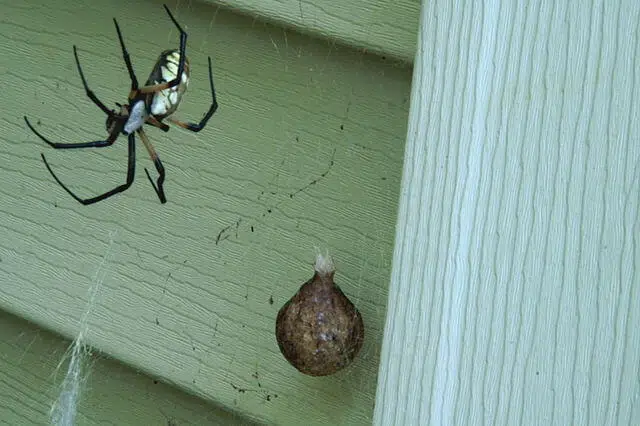
Some spiders carry the egg sack with them attached to the spinnerets. When spiderlings emerge, they climb on the female spider where they remain for up to a few days before moving along and starting life on their own.
Spider Egg Sac Identification
Spider egg sacs vary in size, color, shape, and laying location. Some of these spider sacks are easy to find and identify while others are rarely seen by humans.
Shape and Texture
The shape and texture of the spider sacks are different from one species to another. Many spider sacs have the shape of a round ball. But the roundness of the sac isn’t characteristic of all spiders. Some lay irregular shape sacs.
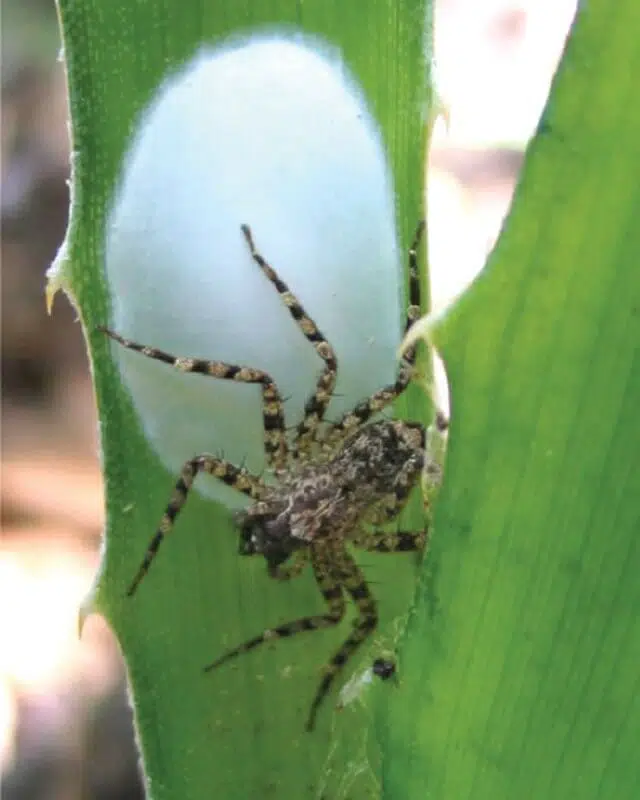
These can’t be categorized by any known shape such as a round ball or a square cube. They are fluffy masses of silk that only aim to protect the eggs. Some spiders even lay sacs with a disc shape. It’s the middle of this disc where the eggs are laid.
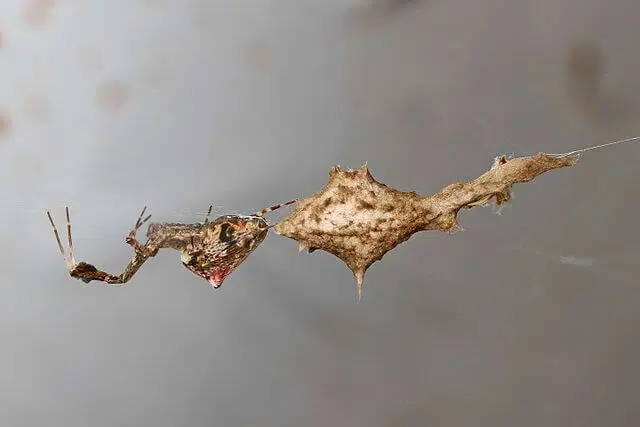
Size
You can identify spider sacks by their size as well. Some spider sacks are larger than others, but they are never as large as a bowling ball. Studies show spider sacs are never larger than the size of the actual spider laying it. This is why most spider sacs are smaller than a coin.
Color
Most spider sacs are white. However, many other spider sacs of an off-white color are sometimes easier to identify.
White spider sacs are normally influenced by the color of the silk produced by spiders. Spider sacs can also be brown or yellow in rare cases.
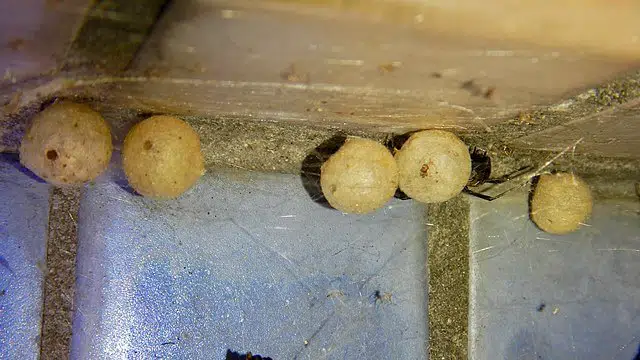
However, spider sacs can never be pink, red, or green. These might be carrying eggs, but not spider eggs.
Location
The easiest way to identify a spider sack is by location. If you see a lump of silk on the spider web, chances are that’s a spider sac. These spider sacs are of spider species that lay sacs, typically in an area close to their habitat or on the spider web, the place they spend most time of their lives.
Spiders that don’t build spider webs can lay sacks in burrows, under leaves, or attach them to different surfaces such as a wall. Spider sacs laid on the ground are the most difficult to identify.
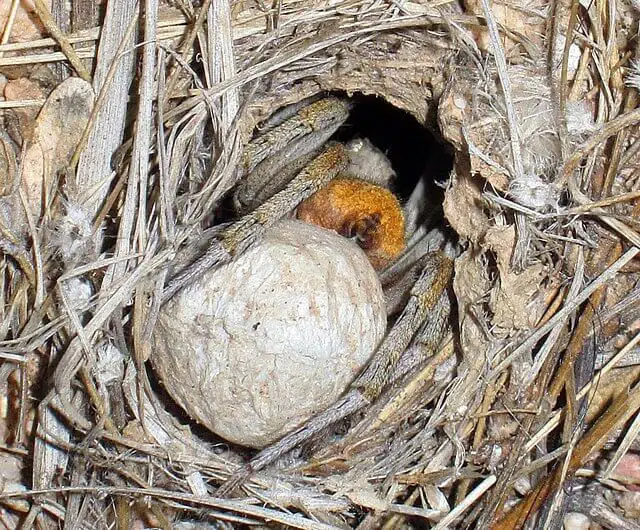
Common Spiders’ Egg Sacs
Some of the egg sacs that are the easiest to identify are laid by common spiders. Black Widow and Wolf Spider egg sacs are the easiest to identify given the popularity of these spiders.
Black Widow Egg Sac
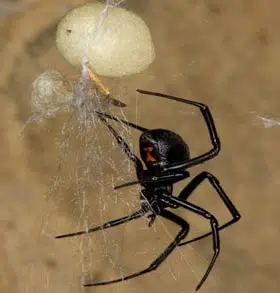
The Black Widow is one of the most dangerous spiders in the US. It lays egg sacs of different colors and different shapes depending on its region. This is why identifying these egg sacs is not easy.
Most Black Widow egg sacs are white. Some are off-white while others are tan or yellow. You can start identifying Black Widow spider sacks by looking at the shape. Round spider sacks are common for the species with pear-shaped sacs being a close second.
A Black Widow egg sac in your house is a sign of trouble as these contain hundreds of eggs. However, it’s rare to see hundreds of spiderlings emerging from one egg sac as the Black Widow female is cannibalistic. The spider eats most of its spiderlings.
Further Reading:
Brown Recluse Egg Sac
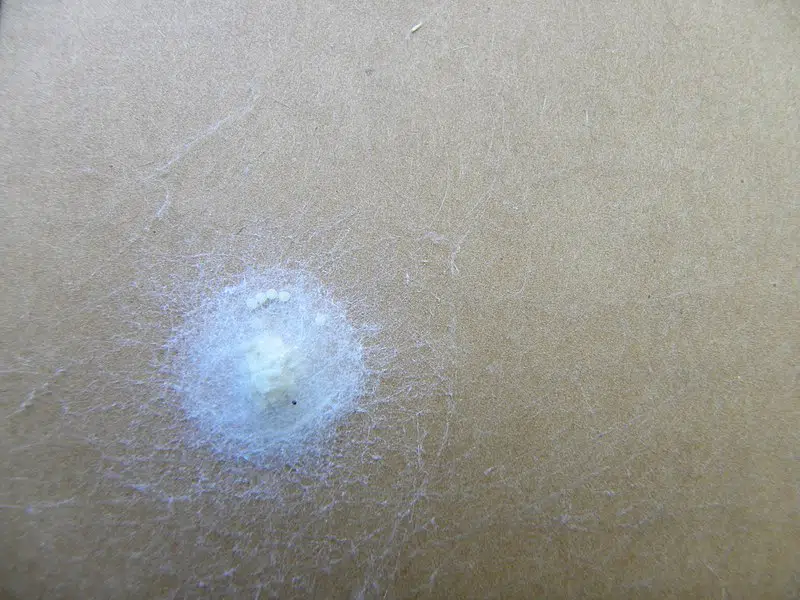
The Brown Recluse is one of the venomous spiders that lay many eggs in a single sac. Most Brown Recluse spider egg sacs have up to 300 eggs inside. But it’s not uncommon to find fewer eggs. As few as 31 eggs have been found laid in Brown Recluse egg sacs.
You can recognize this spider sac by its off-white color. This sac isn’t a perfect round ball. It has a fuzzy round shape with loose woven silk on its outer edge. Spiderlings are in the sac for at least one molt.
Further Reading:
Wolf Spider Egg Sac
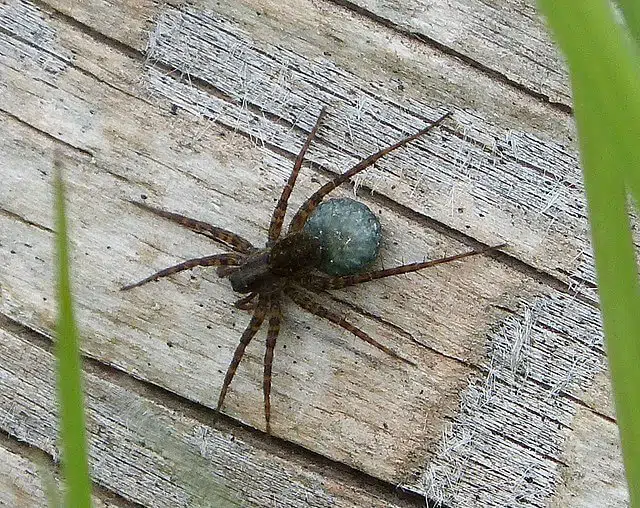
Wolf Spiders lay up to 100 eggs in an egg sac. These spiders are roamers, part of a group of spiders that don’t build spider webs. This is why they don’t have a web to lay the sac on.
In turn, female spiders carry the egg sacs on their body attached to the spinnerets. This protects the eggs from predators.
Garden Spider Egg Sac

Garden Spider egg sacs typically contain around 50 eggs. These are almost spherical as they are narrower on aside. These egg sacs can be recognized by their brown color. These are also some of the most durable egg sacs as they resist high wind.
House Spider Egg Sac
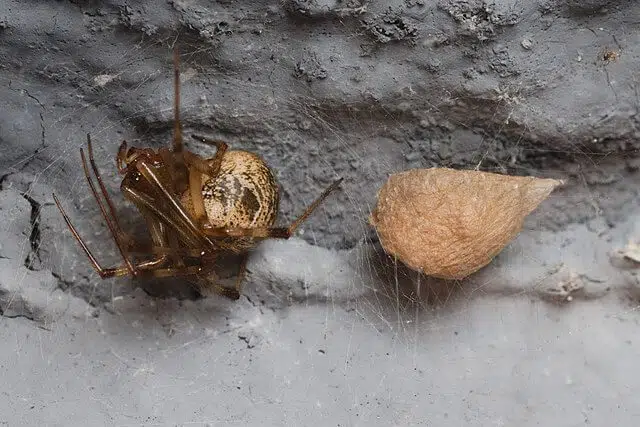
The house spider egg sack is spherical with spike-like formations on its outer surface. These are some of the egg sacs spiders can hide on the spider web or carry with them around the house.
Large egg sacs are specific to this species as each sac contains at least 150 eggs. They can contain up to 300 eggs each. However, House Spider eggs are known for a very low survival rate.
Jumping Spider Egg Sac
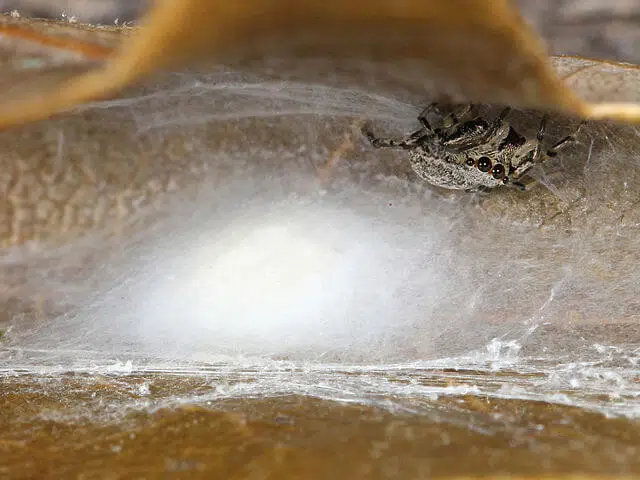
These spider egg sacs are white or off-white. These are normally laid in special structures made out of silk. These structures resemble a classic tent. The egg sac is laid here for protective purposes.
This silken structure protecting the egg sac also protects Jumping Spiders during the winter through the hibernation period.
Daddy Long Leg Egg Sac
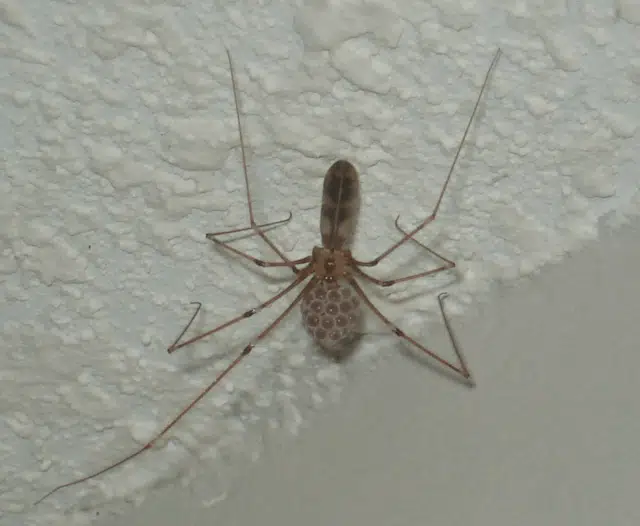
Daddy Long Leg spiders carry the egg sac with them. Hundreds of eggs are found in this white and tan irregular shape sac. Up to 700 eggs are found in the sac.
However, there’s evidence to show many of these eggs aren’t fertilized. Daddy Long Leg egg sacs contain a mix of both fertilized and unfertilized eggs.
Hobo Spider Egg Sac
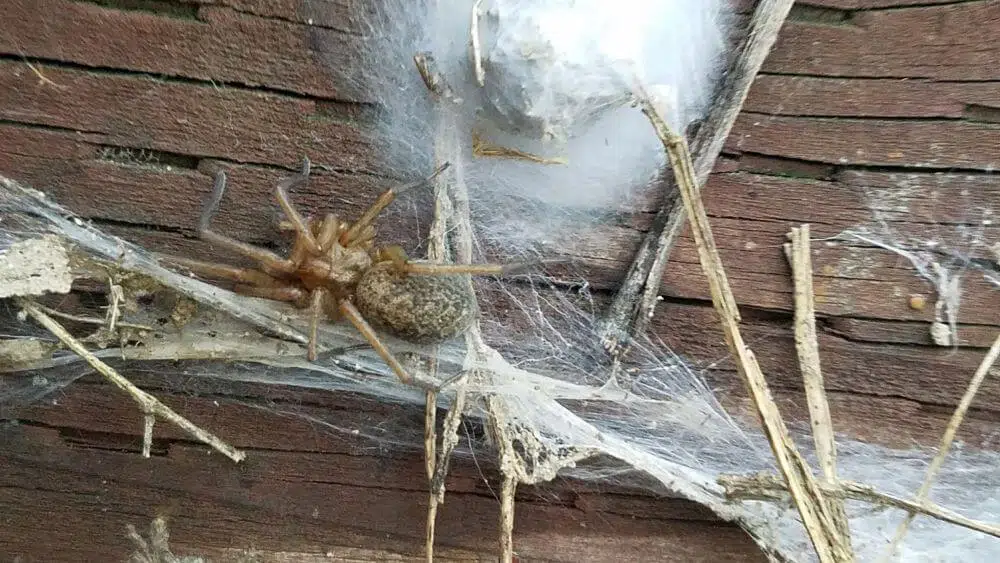
The female Hobo spider lays anywhere between one and 4 egg sacs. They contain up to 100 eggs each. Hobo Spider egg sacs are made with silk and dirt for extra durability. The Hobo Spider attaches the egg sac to hard surfaces in sheltered areas and shortly dies.
What to do when you find an egg sac?
A spider egg sac inside the house is problematic. It creates an even larger problem compared to finding a single spider as a destroyed spider sac can release hundreds of spiderlings that can escape through the house.
You need to remove the spider sac whenever you find one in your home. Frequently vacuum all floors and remote areas behind furniture to ensure your home is free from spider egg sacs.
One common mistake when seeing a spider egg sack is to squish it. But stepping on a spider egg sac can accidentally release tens or hundreds of spiderlings around the house.
Even spraying them with vinegar isn’t recommended as the acid in natural vinegar doesn’t have sufficient potency to fully destroy the egg sack and the eggs.
How To Get Rid Of Spider Egg Sacs
Vacuuming is the easiest method of removing spider egg sacs. You can vacuum each egg sac individually and then dispose of the vacuum dust bag. Make sure you don’t break the spider egg sac before vacuuming it as this can release tens and hundreds of spiderlings through the house.
All vacuumed egg sacs need to be placed in a sealed bag when taken to the trash can. They can still hatch inside the trash which doesn’t eliminate the spider problem around the house.
How to Tell If a Spider Egg Sac Empty?
Empty spider egg sacs are easier to move by the wind. You can blow them lightly to see how easy they move. An empty egg sac will move around easily when air is blown as they are pure silk.
Empty egg sacs are also not of a perfect cocoon or sphere shape as they have open areas through which spiderlings have emerged.
Will Vinegar Kill Spider Egg Sacs?
A solution of vinegar and water can kill spiders due to the high concentration of acetic acid. But not egg sacs can be killed using vinegar as they are sometimes constructed to last in front of danger.
For example, Hobo spiders create multi-layered spider egg sacs. These are separated by a layer of soil which might be hard for the vinegar to penetrate fully.
Will Raid Kill Spider Egg Sacs?
Raid and other special solutions kill spider egg sacks. They are made with chemicals that break down silk and spider eggs quickly. They are applied from a close distance for quick results.
Can You Squish a Spider Egg Sac?
Squishing spider egg sacs is not recommended. This is only going to trigger possible larger problems by releasing hundreds of spiderlings.
Not all spiderlings develop at the same rate. Some eggs might already be hatched inside what seems a simple spider egg sac. Squishing the spider egg sacs normally releases spiderlings from hatched eggs.
Can You Burn a Spider Egg Sac?
Fire destroys many types of spider egg sacs. However, fire can sometimes create minimum damage to a spider egg sac essentially not affecting the eggs inside. As some spiders use soil and other debris when creating the spider egg sac, the durability of these silk builds can be impressive.
It’s best to avoid burning any spider egg sacs in favor of disposing of them using different methods.
Summary
Spider egg sacs are recognized by shape, size, and color. Some of these are found through the house, especially in hard-to-reach areas or places that aren’t vacuumed frequently.
You can recognize a spider egg sack by looking at the color and size of the woven silk build. This is normally a white or an off-white ball that is smaller than a dime.
Spider egg sacs can be laid on the spider web. Many times this egg sac is attached to other surfaces in hard-to-reach areas such as behind furniture when found in homes or under rocks when laid outdoors.
Spiders often build woven shielding structures around the laid egg sac when they don’t build a spider web. Jumping spiders are known for building such protective structures for the egg sac.
Other species of spiders such as Wolf Spiders rarely lay an egg sac. Females of the species carry the egg sac attached to the spinnerets. They hold on to the egg sac until all eggs hatch and spiderlings tend to climb the female where they live for a few days.
Most eggs inside an egg sac never fully develop as spiderlings. Some of these spiderlings are even seen as food by the hungry female such as in the case of the female Black Widow eating most spiderlings.
Other spider egg sacs are mostly populated by unfertilized eggs such as in the case of Daddy Long Legs spiders.
It’s best to vacuum spider egg sacs when found inside the home. These need to be disposed of as neither vinegar nor fire can fully destroy them. Squishing spider egg sacks isn’t better either. This tends to release hundreds of spiderlings that immediately run making their way through the house.